Hologram
a hologram and hologram technology, applied in the field of holograms, can solve the problems of poor solvent resistance and chemical resistance, poor quality reliability in high temperature environments, and change in hologram properties,
- Summary
- Abstract
- Description
- Claims
- Application Information
AI Technical Summary
Problems solved by technology
Method used
Image
Examples
example 1
A hologram according to an embodiment of the invention will now be explained with reference to FIGS. 1 to 8.
The hologram 7 of this embodiment, as shown in FIG. 1, comprises a hologram element 3 containing a photopolymer, a cover film 21 covering the top side of the hologram element 3 and a cover plate 22 covering the bottom side of the hologram element 3. The hologram element 3 and cover film 21 and the hologram element 3 and cover plate 22 are bonded together with an adhesive 1 consisting of an acrylic resin of molecular weight of 1,000,000.
The method of producing the hologram will now be explained.
First, as shown in FIG. 2, an applicator 8 is used to coat a glass substrate 5 with a photopolymer composition to a dry film thickness of 20-40 .mu.m to form the hologram 3. Other methods include spin coating, dipping and bar coating methods.
Next, heat treatment is carried out for about 30 minutes at a temperature of around 100.degree. C. volatilize and remove the solvent in the hologram...
example 2
This example, as shown in FIG. 9, had a structure wherein one side of the hologram element 3 was coated with a PET film 52 made of polyethylene terephthalate for recording the interference bands on the hologram element, while the other side was attached to a glass substrate 5. The hologram element 3 used was a photopolymer composition of the same material as in Example 1.
Specifically, the hologram element 3 used was one with a film structure coated on both sides with a PET film. For recording of the interference band, the PET film on one side of the hologram element 3 was released, while the other side was attached to the glass substrate 5 by the tackiness (adhesion) of the hologram element 3, to prepare a photographic plate 6.
A glass plate 66 with an anti-reflection film 65 was positioned on the photographic plate 6.
Next, argon laser light beams 75, 76 were irradiated from the same side of the photographic plate 6 for polymerization of the first monomer of the photopolymer composit...
example 3
In this example, as shown in FIG. 10, the effect of changes in the molecular weight of the adhesive on the durability of holograms at high temperature (high temperature durability) was investigated.
The molecular weight of the adhesive was varied from 500,000 to 1,500,000. The holograms were otherwise produced in the same manner as in Example 1.
Each hologram was placed in a high temperature environment of 100.degree. C. and the change in the reproduction wavelength was measured periodically. The results are shown in FIG. 10.
As seen in this drawing, the holograms having adhesives of molecular weight 1,300,000 and lower exhibited no change in the reproduction wavelength even when allowed to stand for 200 hours and longer, thus demonstrating their excellent durability.
PUM
 Login to View More
Login to View More Abstract
Description
Claims
Application Information
 Login to View More
Login to View More - R&D
- Intellectual Property
- Life Sciences
- Materials
- Tech Scout
- Unparalleled Data Quality
- Higher Quality Content
- 60% Fewer Hallucinations
Browse by: Latest US Patents, China's latest patents, Technical Efficacy Thesaurus, Application Domain, Technology Topic, Popular Technical Reports.
© 2025 PatSnap. All rights reserved.Legal|Privacy policy|Modern Slavery Act Transparency Statement|Sitemap|About US| Contact US: help@patsnap.com



